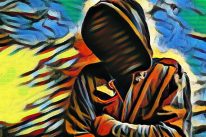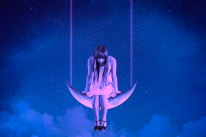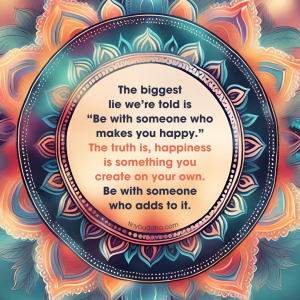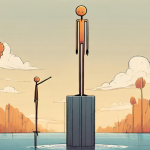
“Ring the bells that still can ring. Forget your perfect offering. There is a crack, a crack in everything. That’s how the light gets in.” ~Leonard Cohen
We human beings are social creatures. For the most part, we like to be with people, and we want people to like to be with us. The trouble is that we get all tied up in trying to communicate a version of ourselves that we think people will find attractive.
We want to appear successful, interesting, in control—and a winner! To keep up this image we work hard to hide away the parts of ourselves that we are not sure about, or we feel don’t work so well. The last thing we want to do is appear weak, or somehow insufficient. So, we project some kind of perfect version of ourselves that will ensure that we are loved and wanted.
The truth is that it’s impossible to keep this act together. Inevitably a moment comes when something gets to us so strongly that we can’t pretend any longer. We appear as we actually are—flawed, brave, struggling, and absolutely human.
This is the moment when we can experience vulnerability as a superpower. When we allow ourselves to be vulnerable, we are not pretending, we are not hiding—we are simply present with whatever is going on inside us. Ironically, it is this very feeling of authenticity that draws people to us, not the brittle effort of perfectionism.
Zero Tolerance for Vulnerability
For many of us our upbringing did not teach us how to be vulnerable; we’ve had to learn as we’ve faced the challenges life’s put in our way.
My mother was an Ulster Protestant from a large, working class family with no patience for emotional frills. Her family was loving but tough, and she brought me up in the same way. I was her first child—emotional, sensitive, curious—and had to bear the brunt of everything she missed about Ireland when she decided to marry an Englishman and settle in London.
From my early years I can remember my mother urging me to hide my feelings from other people and never, ever to let them see when I was hurting, or in pain. She warned me that if I did, then I would be seen as showing weakness, and then I would be fair game to be taken advantage of, and ultimately, made a fool of.
She was my mother, and she was trying to protect me by instilling in me the values she herself had grown up with. It took me years—and sometimes I still fall back—to realize that the voice in my head urging me not to make a fool of myself, to keep my distance, was my childhood internalization of my mother’s fears.
The idea of finding strength in allowing myself to be vulnerable was a remote flicker on the edge of my consciousness.
Shame as Vulnerability’s Implacable Enemy
Brené Brown is a leading researcher into shame and vulnerability. She defines shame as “the intensely painful feeling or experience of believing that we are flawed and therefore unworthy of love and belonging.”
Kristen Neff, well-known self-compassion researcher, tells us that shame was the evolutionary way of hiding our defects from others so that they would include us in the group. Being kicked out of the tribe meant certain death.
For shame to exist it needs secrecy, silence, and a sense of judgment. It’s very hard to for us to speak out about the things we are ashamed of. So, when we make a mistake, it’s more automatic to try and cover it up or blame someone else than to admit that we got something wrong—because then we’d be showing that we are vulnerable.
My Own Story of Shame and Vulnerability
There came a moment in my life when it became clear that I was unable to have children. I had always wanted a large family, and the idea of having no children at all was devastating.
Of course, there was a tremendous grief to deal with, but what took me unawares was the intense feeling of shame. My younger sisters were starting families, as were several of my friends, and I felt excluded from an important female rite of passage. My parents’ disappointment was palpable—never mind that other areas of my life were going well, I was not going to be a mother.
I remember how drawn I was to babies and young children, viewing them as if from the other side of a huge divide. One awful day I found myself walking around the baby department of a large department store, looking at all the tiny outfits and toys. I realized how nervous I was, guiltily looking over my shoulder to see if anyone was watching me.
There was a voice in my head that saying, “You are not a proper woman. Don’t hang around in here, they will be on to you and throw you out. You have no right to be here!”
It was so insidious that I left the store.
Instead of caring for my sorrow and accepting my feelings of vulnerability, I felt inadequate and ashamed. It seemed I was the worst person in the planet, someone who had no right to even think of being a mother. Eventually I was fortunate enough to find an excellent counselor at a woman’s center who helped me work it through and accept my situation without shame.
Recognizing Another Person’s Vulnerability Helps You Accept Your Own
I remember feeling so ashamed of not being able to have children that I forgot all the other people who discover that they are infertile for one reason or another. My feeling was that I was the lowest of the low and that nobody could be as pathetic as I was. Many years later, while having radiotherapy treatment, a very different perspective opened up for me.
Anyone who has had cancer and undergone a period of radiotherapy knows that it involves a daily visit to the hospital, five days a week, for a number of weeks. You show up to the same place every day and meet the same hospital staff—you become a regular.
The thing you don’t tend to think about so much is that just as you are turning up every day, so are a whole bunch of other people. You get to recognize some of them, you maybe even get to talk a bit. Most of the time people come with a partner, a family member, or a friend.
You can always tell which person is sick—they have an air of vulnerability about them. You can see their friend doing their best to care for them. There was a deep sense of care and even love in the waiting area.
I remember an elderly woman who had obviously already been through chemotherapy. She was wearing a wig, but it did not fit so well. I saw her husband gently straighten it on her head with such tenderness. It brought home to me that vulnerability is part of the human condition.
We all have to face stuff that challenges us and frightens us. No one is immune to suffering and pain. As human beings we are all in the same boat, doing our best to navigate our way through whatever life puts in our way.
Seeing other people as vulnerable helped me to accept my own vulnerability. Allowing myself to be vulnerable was a tremendous relief, a starting place for some kind of self-awareness.
Observing all these people facing their fears and anxieties with patience, and quiet dignity, brought home to me that it’s when we allow ourselves to be vulnerable that we can find our deepest courage and strength.
The Japanese art of Kintsugi
I came across this art form almost by accident. Broken pottery is mended with lacquer mixed with powdered gold, silver, or platinum. Instead of trying to mend the pieces invisibly, hiding the fact that they were ever broken, the cracks are transformed into decorations. The pieces become more valuable because of their flaws.
For me, this is the perfect symbol of vulnerability as a superpower. We move from trying to hide it, to accepting that it is there and arrive at a place where we can transform the lessons we have learned into wisdom and understanding.
About Maureen Cooper
Maureen Cooper runs Awareness in Action, and offers workshops, online courses and coaching on integrating meditation and kindness into all aspects of everyday life. If you enjoyed this article check out her online course on self-compassion, How to Be a Good Friend to Yourself . You can follow Maureen on Twitter & Facebook.
- Web |
- More Posts













 Though I run this site, it is not mine. It's ours. It's not about me. It's about us. Your stories and your wisdom are just as meaningful as mine.
Though I run this site, it is not mine. It's ours. It's not about me. It's about us. Your stories and your wisdom are just as meaningful as mine. 